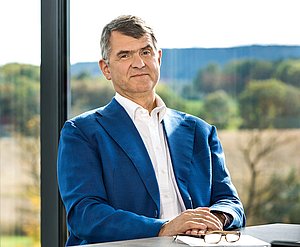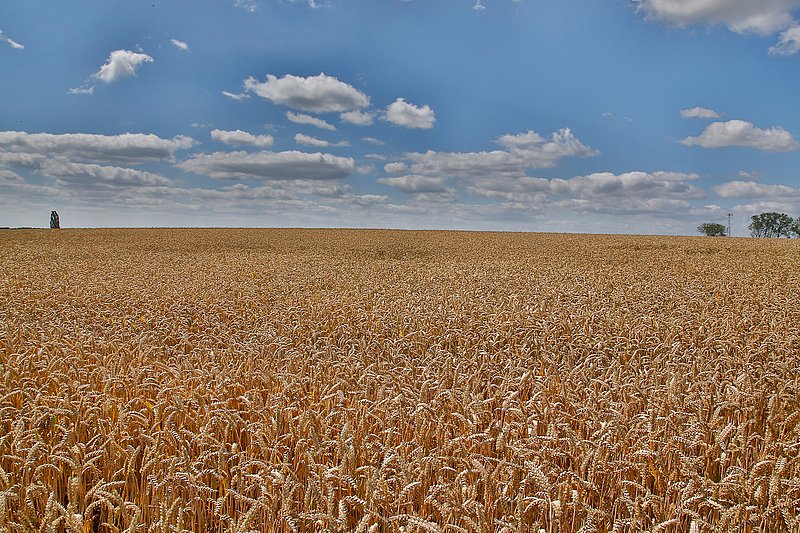Climate – did we miscalculate!?
The prices for energy or logistics increased considerably. Cereal prices, too, keep on rising. Because of weather extremes like heavy rainfall, floods or droughts harvest yields suffer. But despite partly low yields the demand is at a constant high. Michael Horsch explains how he assesses the current situation at the cereal market, what a shortage would mean in theory and how HORSCH deals with it.

terraHORSCH: The situation at the cereal market is tight, the prices are, too. The demand is high. The climate gets to the farmers and their yields. Are we in trouble?
Michael Horsch: First of all: We must be allowed to ask this question and to think about what this would mean. To think this scenario through to prepare a solution. Personally, I would not go to such lengths and believe that we already are right in the middle of it. But we have to deal with future topics, and we should not close our eyes on what is happening at the moment. This does not mean that we should overreact.
What you have to know when looking at such a scenario: Another increase of the global yields is not to be expected in the near future. There is almost exactly one billion hectares of arable land where we produce three billion tons of cereals like maize, wheat, rice and other cereals as well as 500 million tons of oleiferous fruit like soya, rape, sunflowers etc. We know that this area will not increase anymore and that by now almost all arable regions in the world are farmed in an optimum way. These 3.5 billion tons of cereals and oilseeds correspond to approx. 70 % of our total calorie intake – directly and indirectly
This means that these approx. 70 % of the calorie requirement that are covered by the arable land respectively the cereals and oilseeds are most important. It is not system-critical if there were less potatoes, less legumes or less apples because of frost. If we run out of microchips, there will be less cars, but we will not starve. If we run out of mineral oil, we will look for alternatives. But there is no alternative to staple food, we need it. So first and foremost, the problem would become critical if cereals became scarce. Especially in the Third World.
We need staple food. There is no alternative.
terraHORSCH: What could be factors for a cereal shortage?
Michael Horsch: For decades, climate researchers predict that our climate will change significantly and that weather extremes will increase. Drought, heat, heavy rainfall, strong winds – there will be more of it. And now we notice: The scientists with their forecasts have a point there. Extreme weather events increased considerably in the past five years as well as their intensity. It is obvious that this influences the harvest especially when a large cereal region is hit. So-called record harvests will decrease because of such events. Of course, there also are countries that benefit from the climate changes, e.g. the Ukraine. In June and July, it now rains more than 20 years ago and temperatures no longer are this high. But the majority of the arable regions all over the world suffer from these changes, Western Europe being one of them.
This year, too, we saw examples what such events can do to our harvest. Three months ago, there was a heat wave in Western Canada with 45-50° in the shade. The soil was wet, and the farmers first thought that this year would be a good year for summer wheat and summer rape. But this was not the case. The heat caused major damage. The result is that at the moment, rape prices are rising drastically. In Brazil, too, the maize harvest was about 30 % lower than expected. And because of the extreme weather, harvest was not only lower, quality was worse, too. In Europe heavy rainfall and floods affect the harvest, in USA or Canada it is extreme heat and drought. One thing leads to another. Harvest is lower, but demand and prices increase. From a farmer’s point of view, the feelings are mixed. For on the one hand, it becomes more and more difficult to achieve good yields, on the other hand you can expect higher prices. But the prices for fertilisers and other raw material like mineral oil etc increase, too.
And what certainly will rise are the prices for leased land. And they will not go down again easily as we know from the past. Farmers then try to protect their yields and to complete their machines in a more differentiated way. Thus, they can optimally react to the respective condition of the soil respectively react with the necessary seed drill and thus create a basis for a better harvest with more yield. If the prices for leased land rise, the machine capital replacement values increase, too!
terraHORSCH: Are there other factors that influence the high prices?
Michael Horsch: Covid 19 and the high mineral oil prices etc. surely have an effect on the cereal price. The question is: to what extent do they really influence it? How probable is it that we really miscalculated, that we really underestimated the climate and that there really will be a shortage?
With hybrid farming it might be possible to withstand a food shortage.
terraHORSCH: What does miscalculated mean?
Michael Horsch: Every month, the USDA (United States Department of Agriculture) publishes reports with forecasts regarding the cereal stocks and the global supply and demand situation. For these reports, they have been calculating for about 50-60 years an average figure of the influence of different factors, e.g. how many El Niños (heavy rainfall), periods of drought and extreme weather events there were, and based on this the ratio for consumption and stock etc. All this is integrated in the statistics, even the past five years. But these five years change the total statistics only to a very small extent as they are combined with the data of the past 50-60 years. If you only regard the past five years, you can see that there was a massive change.
If you consider the past two years you cannot help but think that there might be something wrong with the statistics and the assumptions. For example, the assumption that there are huge maize and soya stocks in China. If this was true, why did China at the beginning of the pandemic buy so much maize and soya although the price had doubled? You can assume that perhaps there are no such stocks. If you take a closer look on how these statistics are established, the problem soon becomes obvious. And of course, you must not forget that the USDA is a political authority and has a certain influence on the stock exchanges.
But I will give you an example from my personal experience: At the beginning of July, I was in contact with farmers from all over Europe. All of them and also my own family, my sons and I, were convinced that there would be a record harvest this year. May was wet and cool, June, too, was cooler and a little bit wet. We stood in the field, rubbed the ears of the crops, looked at the grains and said: They are not large, but there are quite a lot. Four weeks later we knew better. Harvest was significantly lower than expected. It definitely was not a bad harvest but compared to our expectations the yield was considerably lower. If you consider all the losses of this year – if the prices are to decrease again, we would need two absolute record years all over the world to reach the Stock to Use values of the USDA from 2019 of which we still thought last year that we will achieve them exactly like that.
Now my question is: How is a statistical authority supposed to assess in advance what will happen, if we farmers with all our experience are no longer able to do so? We, too, were wide off the mark and miscalculated. We have to accept and to prepare for it that suddenly occurring weather extremes might affect the yield expectation to a greater extent than in the past.

terraHORSCH: What could be solutions to prevent qualitative and quantitative harvest losses?
Michael Horsch: The question, of course, is what we Germans and we Europeans could imagine. So far, we have been pursuing the ecologisation of farming. This was also our approach at HORSCH. But now we have to ask ourselves: Is it still the right path? With the increasing ecologisation we risk reducing the amount of cereals for staple food and thus, the prices will continue to rise. From the point of view of society, environment and groundwater this ecological orientation definitely makes sense.
But with the prices, political conflicts and Third-World-countries in mind who cannot afford to pay these prices we have to reassess the situation. It would only force people to flee. We are, of course, describing a hypothetical scenario but who can say for sure that it might not happen this way and that reality sooner or later will catch up with us?
In my opinion we have to continue to rely on hybrid farming. This means: not abandon the ecologisation idea completely, but thinking about it with the “maximization of calories” in mind. The more we try to make organic farming the cure-all to save the world the more we destroy it. We should not let this happen. With hybrid farming, i.e. the combination of conventional and organic farming, it might be possible to withstand a food shortage.
Moreover, and this is also analogously included in the working paper „Future of Agriculture“ that was commissioned by the BML*, we should slowly reduce our meat consumption. This is important for health and for climate reasons but definitely also with regard to the food shortage.
And what in my opinion is also important: To me, the future of agriculture does not mean to look for solutions only in the digitalisation sector. I think, we also should focus on microbiology. For this is where we probably find more approaches to solve the problems of food production – today and in the future – in a quantitative and in a qualitative way. This is the most important part of the hybrid idea, but this means that it cannot be achieved completely without fertiliser and thus chemistry. What counts is the optimum balance. We have to get rid of this black-and-white thinking.
*When working on the paper the parties together with different NGOs from the Bund Naturschutz (association for the protection of the environment) to the chemical industry and the farmers’ association agreed on the direction agriculture is to take in the future.